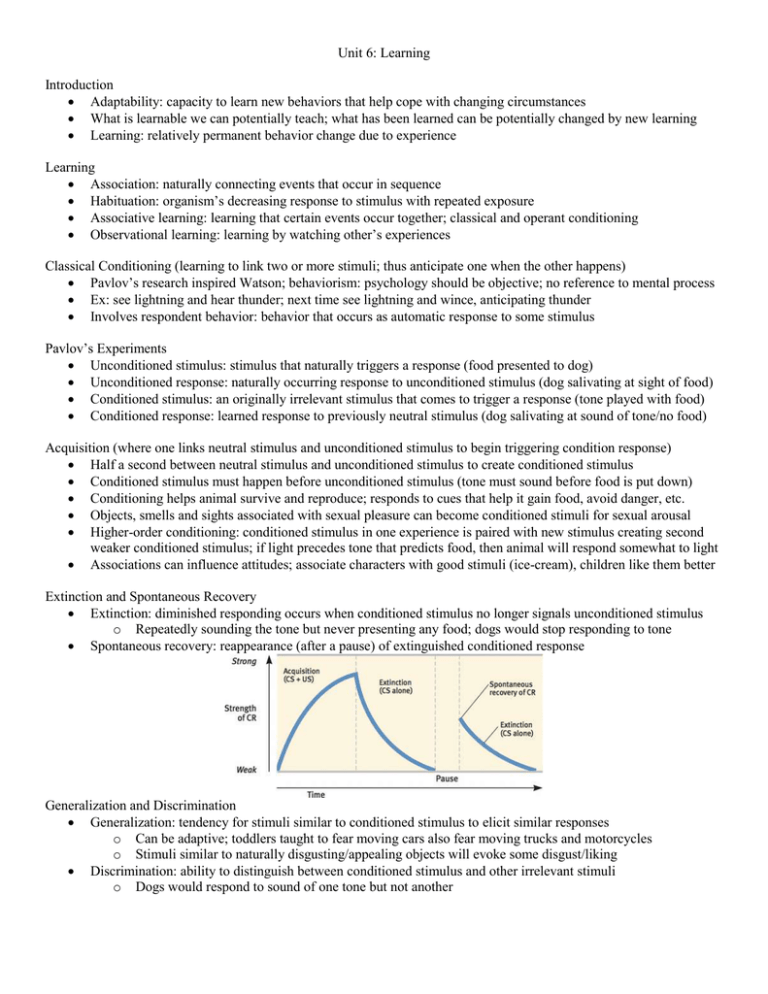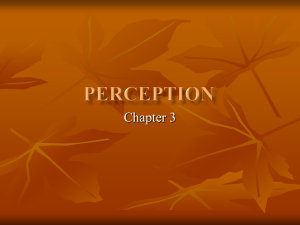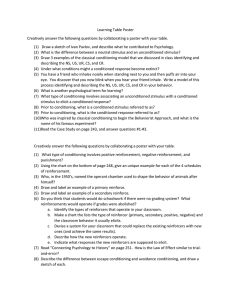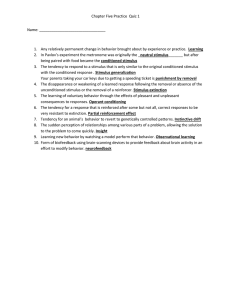File - notes
advertisement

Unit 6: Learning Introduction Adaptability: capacity to learn new behaviors that help cope with changing circumstances What is learnable we can potentially teach; what has been learned can be potentially changed by new learning Learning: relatively permanent behavior change due to experience Learning Association: naturally connecting events that occur in sequence Habituation: organism’s decreasing response to stimulus with repeated exposure Associative learning: learning that certain events occur together; classical and operant conditioning Observational learning: learning by watching other’s experiences Classical Conditioning (learning to link two or more stimuli; thus anticipate one when the other happens) Pavlov’s research inspired Watson; behaviorism: psychology should be objective; no reference to mental process Ex: see lightning and hear thunder; next time see lightning and wince, anticipating thunder Involves respondent behavior: behavior that occurs as automatic response to some stimulus Pavlov’s Experiments Unconditioned stimulus: stimulus that naturally triggers a response (food presented to dog) Unconditioned response: naturally occurring response to unconditioned stimulus (dog salivating at sight of food) Conditioned stimulus: an originally irrelevant stimulus that comes to trigger a response (tone played with food) Conditioned response: learned response to previously neutral stimulus (dog salivating at sound of tone/no food) Acquisition (where one links neutral stimulus and unconditioned stimulus to begin triggering condition response) Half a second between neutral stimulus and unconditioned stimulus to create conditioned stimulus Conditioned stimulus must happen before unconditioned stimulus (tone must sound before food is put down) Conditioning helps animal survive and reproduce; responds to cues that help it gain food, avoid danger, etc. Objects, smells and sights associated with sexual pleasure can become conditioned stimuli for sexual arousal Higher-order conditioning: conditioned stimulus in one experience is paired with new stimulus creating second weaker conditioned stimulus; if light precedes tone that predicts food, then animal will respond somewhat to light Associations can influence attitudes; associate characters with good stimuli (ice-cream), children like them better Extinction and Spontaneous Recovery Extinction: diminished responding occurs when conditioned stimulus no longer signals unconditioned stimulus o Repeatedly sounding the tone but never presenting any food; dogs would stop responding to tone Spontaneous recovery: reappearance (after a pause) of extinguished conditioned response Generalization and Discrimination Generalization: tendency for stimuli similar to conditioned stimulus to elicit similar responses o Can be adaptive; toddlers taught to fear moving cars also fear moving trucks and motorcycles o Stimuli similar to naturally disgusting/appealing objects will evoke some disgust/liking Discrimination: ability to distinguish between conditioned stimulus and other irrelevant stimuli o Dogs would respond to sound of one tone but not another Cognitive Processes Rescorla and Wagner: the more predictable the association, the stronger the conditioned response o Light followed by tone followed by shock; rats react with fear to tone; tone better predictor of shock Learned helplessness: passive resignation organism learns when unable to avoid repeated aversive events o Dogs strapped and given shock; would not run when unstrapped and given shock; felt hopeless o Dogs escaped first couple of shocks; would run when unstrapped and given shock, did not feel hopeless Thought important in classical conditioning; if alcoholic knows nausea is caused by drugs and not the alcohol, the connection between drinking and feeling sick is weak; aversion to alcohol is not strong Biological Predispositions Pavlov and Watson believed learning was essentially similar in all animals; disproved by researchers Garcia and Koelling o US does not have to immediately follow CS (rats avoided flavor causing nausea even after several hours) o Biologically predisposed to learn some associations over others (rats avoid smell not sight; hunt by smell) Humans predisposed to make associations between color red and women’s sexuality; sexier when wearing red! Ancestors who learned taste aversions were unlikely to eat toxic food again and survived and left descendants Influences on learning Biological: genetic predispositions, unconditioned responses, adaptive responses Psychological: previous experiences, predictability of associations, generalization, discrimination Social-cultural: culturally learned preferences, motivation affected by presence of others Pavlov’s Legacy Many other responses to many other stimuli can be classically conditioned in many other organisms Classical conditioning is one way virtually all organisms learn to adapt to their environment Pavlov showed how process (such as learning) can be studied objectively; new scientific model for psychology: isolate basic building blocks of complex behaviors and study them with objective laboratory procedures Applications of Classical Conditioning Watson and Rayner: emotions and behaviors are conditioned responses; Little Albert experiment o Showed how fears can be conditioned; made loud noise behind Albert when rat appeared; Albert became afraid of the rat after several days; showed generalization to rabbit and dog but not toys Operant Conditioning (behavior is strengthened with reinforcer or diminished with punisher) Skinner’s Experiments Law of effect: Thorndike’s principle that behaviors followed by favorable consequences become more likely Operant chamber (Skinner box): contains bar/key that animal can manipulate to obtain food or water reinforcer Shaping Behavior (shaping: reinforces guide animal’s actions toward desired behavior) Successive approximations: reward responses that are ever-closer to final desired behavior Animals shaped to respond to one stimulus and not another means they see the difference between the stimuli o Can be used to answer questions such as, “can the dog discriminate between red and green?” Discriminative stimulus: stimulus that elicits response after association with reinforcement o Ex: pigeon taught to peck after seeing human face; face is discriminative stimulus Types of Reinforcers (reinforcer: any event that strengthens the behavior it follows) Positive reinforcement: increasing behavior by presenting positive stimuli; strengthens response when presented Negative reinforcement: increasing behavior by reducing negative stimuli; strengthens response when removed Primary reinforcers: innately reinforcing stimulus; unlearned; one that satisfies biological need Conditioned reinforcers: gains power through association with primary reinforcer; rat presses light to gain food Immediate/Delayed Gratification Children who learn delayed reinforcement tend to become more socially competent and higher-achieving adults Immediate gratification more alluring than delayed consequences (watching late TV but feeling dead in morning) Reinforcement Schedules Continuous reinforcement: reinforcing desired response every time it occurs; learning and extinction occur rapidly Partial/intermittent reinforcement: reinforcing response part of the time; learning and extinction occur slowly Fixed-ratio schedules: reinforce behavior after set number of responses (free drink every 10 purchases) Variable-ratio schedules: reinforce behavior after unpredictable number of responses (slot-machines, fly fishers) Fixed-interval schedule: reinforce behavior after time period; behavior goes up as time is closer (checking mail) Variable-interval schedules: reinforce behavior after varying time intervals; behavior is consistent (text message) Punishment (any event that decreases the behavior it follows) Positive punishment: decreasing behavior by presenting negative stimulus (spanking, parking ticket) Negative punishment: decreasing behavior by removing positive stimulus (time-out, taking away driver’s license) Sureness (likeliness) and swiftness influences effectiveness (direct relationship) Drawbacks in physically punishing children: punished behavior is temporary suppressed but not forgotten; teaches discrimination (swearing outside of house, but does not stop swearing), can teach fear (fear of people that administered it; skipping school if punished in school), demonstrates that aggression is way to cope with problems Punishment tells you what not to do; reinforcement tells you what to do; reinforcement more effective Cognition and Operant Conditioning Latent learning: learning that becomes apparent only when there is some incentive to demonstrate it o Rats would explore maze for 10 days; food would be placed at end of maze on 11 day o Rats that explored without food would finish maze faster than rats reinforced with food all along o Seemed to develop cognitive map of maze: mental representation of layout of one’s environment Learning can occur with little interaction with environment; insight: sudden realization of solution to a problem o Can puzzle over a problem and suddenly perceive solution in flash of insight Intrinsic motivation: desire to perform behavior for its own sake; rewards can undermine intrinsic motivation o People lose joy in doing something they love and will not do it because they are being paid to do it o “If I have to be bribed into doing this, it must not be worth doing for its own sake.” Extrinsic motivation: desire to perform behavior to receive rewards or avoid punishment Biological Predispositions Biological constraints predispose organisms to learn associations that are naturally adaptive o Ex: pigeons will peck to get food (natural behavior) but will not flap wings to obtain food (unnatural) Instinctive drift: animals tend to revert to biologically predisposed behaviors o Ex: pigs will pick up toys with mouths but eventually tend to push it with noses as they naturally do Skinner’s Legacy External influences (not internal thoughts and feelings) shape behavior; applies to humans too Critics said he dehumanized people by neglecting personal freedom and trying to control their actions Responded by saying reinforcers more humane than current punishments; gives hope that we can shape future Applications of Operant Conditioning Computers could provide individualized instruction to students; could go at each student’s rate of learning Key to shaping athletic behavior is to reinforce small success and then gradually increase the challenge Reward specific achievable behaviors but not vaguely defined merit in work areas; o Even specific criticism has least resentment and greater performance boost when specific and considerate Parents give children attention and other reinforcers when they are behaving well but try to avoid punishments Self-improvement: state goal in measurable terms and announce it; monitor how often you engage in desired behavior; reinforce desired behavior (give yourself a reward); reduce rewards gradually Comparing/Contrasting the Classical and Operant Conditioning Forms of associative learning Involve acquisition, extinction, spontaneous recovery, generalization, discrimination Both influenced by cognitive processes and biological predispositions Observational Learning (learning by observing others; social learning) Modeling: the process of observing and imitating a specific behavior Even at 2.5 years old when mental abilities at same level as chimps; humans surpass chimps at social tasks involving copying another’s solution a problem Mirrors in the Brain Rizzolatti: discovered mirror neurons (frontal lobe neurons that fire when performing certain actions or when observing another doing so); similar brain activity in person imagining situation as person experiencing situation Mirror neurons generate “inner simulation” enabling to experience someone else’s experience; enables empathy Mirror neurons underlie human’s social nature Bandura’s Experiments Children would imitate actions and words used by adult on Bobo doll when their toys were taken away More likely to imitate people perceived as similar, successful and admirable as ourselves Applications of Observational Learning Behavior modeling used to train communications, sales and customer service skills to trainees; gain skills faster Prosocial Effects Prosocial behavior: positive, constructive, helpful behavior People who exemplify nonviolent, helpful behavior can prompt similar behavior in others Observational learning of morality begins early; toddlers who imitate prosocial parents have strong consciences Models most effective when actions and words are consistent (non-hypocritical) Antisocial Effects Aggression is both genetic and environmental (observationally learned) TV is powerful source of observational learning; can teach that bullying is effect way to control others, free and easy sex bring pleasure without misery or disease, men should be tough and women gentle Violence-viewing effect: violence on television does lead to aggressive behavior; especially when attractive person commits seemingly justified, realistic violence that goes unpunished and causes no visible pain or harm o Stems from imitation; children will imitate acts they observe on TV o Stems from desensitization; viewers with prolonged exposed to violence become indifferent to it







